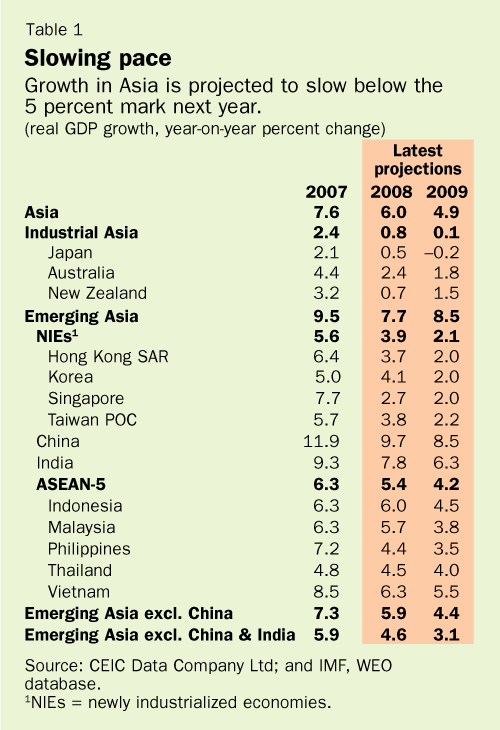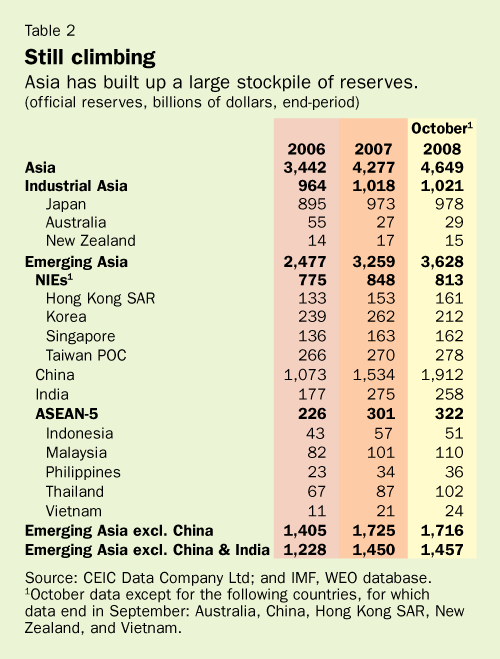
Typical street scene in Santa Ana, El Salvador. (Photo: iStock)
IMF Survey: Asian Growth to Slow Sharply in 2009, IMF Says
November 24, 2008
- Global downturn puts new stress on Asia, curbing export growth
- Fall in commodity prices reduces inflation risks
- Policymakers need to react decisively to maintain stability
Growth in Asia, battered by the effects of the financial crisis that began in advanced economies and is now engulfing emerging markets, is expected to slow sharply in 2009, the IMF says in its latest forecast for the region.

Workers make umbrellas at a factory in China's Fujian province. The global financial crisis is expected to slow demand for Asian exports (photo: AFP)
REGIONAL ECONOMIC OUTLOOK
On an annual average basis, growth in Asia is projected to slow from 7.6 percent in 2007 to 6.0 percent this year and 4.9 percent in 2009, according to the IMF's Regional Economic Outlook for Asia and Pacific, which was released on November 24 (see Table 1).
"With the recent intensification of the global financial turmoil, any hopes that Asia would escape the crisis unscathed have evaporated. Despite its strong fundamentals—notably a substantial cushion in external reserves and robust corporate and banking sectors—the region is being buffeted by large external shocks," said Jerald Schiff, a Senior Advisor in the IMF's Asia and Pacific Department.

Waning export demand
In a media briefing he gave two key reasons for the slowdown:
• Global demand for Asia's exports is waning, with the economies of the euro area, Japan, and the United States in a deep slump, and forward-looking indicators pointing to a sharper decline ahead
• The financial environment has become extremely challenging. Global deleveraging is contributing to tighter financing conditions, capital outflows, depressed equity prices, a weakening of a number of regional currencies, and higher sovereign and bank spreads.
Slowing economic growth and lower commodity prices are already contributing to moderating inflation, and the report expects a continued decline over the course of 2009, with headline consumer price inflation for the region falling from 6 percent this year to just over 3 percent in 2009.
Risks to the outlook
While the baseline scenario for Asia sees recovery beginning in the second half of 2009, risks to the outlook are significantly larger than usual and tilted strongly to the downside, the report warned. A deeper and more protracted global slowdown than currently anticipated, combined with tighter international financial conditions from the ongoing global deleveraging, could have significant spillovers to the region through both exports and a range of financial channels. Most notably, slowing growth is likely to contribute to rising bad loans for regional banks, and risking an adverse cycle of tightening credit conditions and deteriorating growth.
It also remains unclear how domestic demand in the region would stand up to a sharp decline in export growth and tighter financial conditions, the report said. Despite Asia's generally strong fundamentals, and large foreign exchange reserves (see Table 2), the region is "being rattled by the crisis due to its close trade and financial integration with the rest of the world."

Policy reactions
"In this difficult environment, policymakers need to focus on ensuring financial stability and the functioning of credit markets, while using macroeconomic policies to support growth," Schiff told the media briefing. "Countries in the region have already taken a number of positive measures to stabilize financial conditions, including exceptional provision of domestic and foreign exchange liquidity and, in several cases, the extension of guarantees on bank deposits and other liabilities. But more may be needed, including public recapitalization of banks, if this becomes necessary."
With inflation having peaked in most countries, there is room for further monetary policy easing. In addition, progress in fiscal consolidation in recent years will allow many countries to put in place stimulus packages, and a number of countries have already moved in this direction, including Japan, Korea, and China.
Background material
The report includes two analytic chapters that address longer-term issues which will affect the region's economies as the impact of the current crisis recedes.
• "The Globalization of Asian Inflation" examines the rising importance of commodity prices in Asia's inflationary process and its potential implications for monetary policy. While inflation in the region could in the past largely be traced back to domestic factors, global relative prices—notably of commodities—have been the driving force behind rising inflation in recent years. Despite the recent downturn, commodity prices are expected to remain high and volatile over the medium term, which would tend to create persistent gaps between core and headline inflation and pose new challenges for policymakers in facing trade-offs between output and inflation volatility.
• "The Graying of Asia: Demographics, Capital Flows, and Financial Markets" analyzes the impact of rapid demographic change in Asian countries on their external positions and capital flows as well as on financial markets and asset prices. In particular, the study shows that vastly different rates of aging across Asia are likely to have sizable effects on current accounts and capital flows—with capital tending to flow "uphill" from younger to older countries. Governments can ease the potentially difficult demographic transition by beginning to take policy measures now. For aging countries, this may involve an emphasis on pension and labor force reform. For younger countries, requiring substantial capital for their growing labor forces, enhancing financial intermediation, and boosting productivity will take center stage.
Comments on this article should be sent to imfsurvey@imf.org







